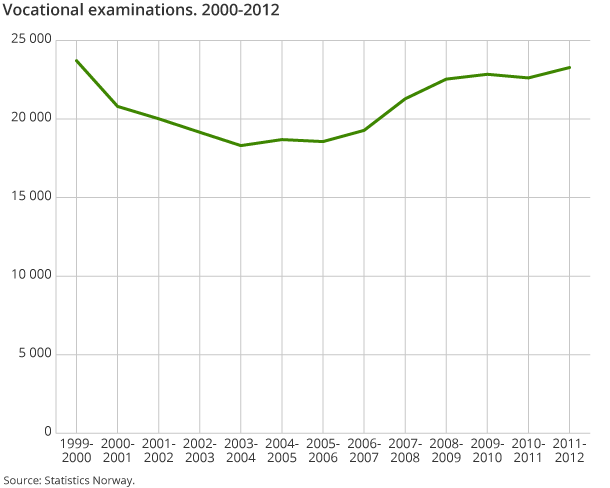Content
Published:
This is an archived release.
More participants are immigrants
Participants in upper secondary education increased by 10 000 in 2012 compared to 2011. Twelve per cent of participants in upper secondary school are immigrants, and the highest increase is found among the share of male immigrants.
| 2012 | 2011 - 2012 | 2008 - 2012 | |
|---|---|---|---|
| Change in per cent | |||
| Pupils | 200 792 | 3 | 7 |
| Apprentices and trainees | 38 858 | 5 | -1 |
| Pupils and apprentices and trainees | 239 650 | 3 | 6 |
| Which | |||
| Immigrants | 20 229 | 15 | 51 |
| Norwegian-born | 8 784 | 6 | 39 |
There are 10 000 more participants in upper secondary education in 2012 compared to the previous year. One half of this increase is attributed to the inclusion of web-based schools in 2012. Upper secondary schools have a total of 200 000 pupils; an increase of 7 000 compared to the previous year, which is mostly attributed to immigrants. The number of immigrants has increased in upper secondary schools and among apprentices and trainees. The participant rate of male immigrants aged 16-18 increased by six percentage points, from 64 per cent in 2011 to 70 per cent in 2012. Ninety-two per cent of all persons aged 16-18 were registered as pupils or apprentices in upper secondary education as of 1 October 2012. Participation rates for girls are slightly higher than for boys.
273 000 participants in upper secondary education
As of autumn 2012, there were 273 000 participants in upper secondary education in total. About 200 000 were pupils, 37 000 were apprentices/trainees, 14 000 were in tertiary vocational schools, and the rest were evenly split among folk high schools and employment training courses with 7 000 participants each. Seventy per cent of all participants were aged 16-18 and 30 per cent were over 18. Programmes for general studies and vocational education programmes had 117 000 and 84 000 participants respectively. Girls were in the majority (55 per cent) at general studies, whereas boys were in the majority (55 per cent) at vocational education programmes. The most popular programmes within vocational education were health and social care , technical and industrial production and electricity and electronics with 45 000 participants. Eighty-five per cent of the participants in health and social care programmes were women, whereas 95 per cent of participants in building and construction programmes were men.
Increasing number of apprentices and vocational examinations
As of 1 October, there were 37 200 apprentices and trainees in upper secondary schools; an increase of 1 900 from the previous year. The proportions of female participants among apprentices and trainees were 28 and 32 respectively.
A total of 23 500 vocational examinations were held; 800 more than in the previous year and about the same as in 2000. Ninety-one per cent of the candidates passed the examination. The highest pass rate was in media and communication with 98 per cent, whereas design, arts and crafts had the lowest pass rate with 84 per cent.
Tertiary vocational schools
The number of students in tertiary vocational education is still high, at about 14 000, and two out of three of these are men. Natural sciences, vocational and technical subjects is the largest special field with 6 000 participants, and 95 per cent of these are men. The second largest is Humanities and arts with 2 800 participants, and in this field the women are in the majority.
Stable number of pupils at folk high schools
The number of pupils in folk high school is around 7 000; about the same as the previous year. As previously, 19 year-olds make up the largest group.
Contact
-
Daniel Instebø
E-mail: daniel.instebo@ssb.no
tel.: (+47) 45 12 72 66
-
Anna-Lena Keute
E-mail: anna.keute@ssb.no
tel.: (+47) 95 44 30 88

